"A woman struggles to be herself in a male-dominated society with laws and judgments shaped by men." - Henrik Ibsen
Henrik Ibsen is considered the world's pre-eminent dramatist of the 19th century and is often referred to as "The father of modern drama."
The statement resonates deeply with the reality of women in the Indian judiciary.
On International Women's Day, it is crucial to examine the status of women judges in India. Despite increased participation in the subordinate judiciary, systemic barriers hinder their progression to higher courts and create a hostile work environment.
Justice B.V. Nagarathna recently pointed out that formal equality in numbers is not enough; an enabling and sensitive environment is necessary to ensure their effective participation.
Participation of Women in the Judiciary
According to the 2023 'State of the Judiciary' report by the Centre for Research & Planning
|
Judicial Level |
Percentage of Women Judges |
|---|---|
|
District Judiciary |
36.3% |
|
States with >50% Women Civil Judges (out of 16 examined) |
14 States |
|
High Court Judges |
13.4% |
|
Supreme Court Judges |
9.3% |
|
High Courts with Female Chief Justice |
1 (Gujarat High Court) |
|
Women in Supreme Court Collegium |
Very Low Representation |
Legal Barriers and Gender-Specific Challenges
Former Chief Justice of India, D.Y. Chandrachud, observed that institutional design never prioritized women. Their journey from entry-level judicial positions to senior roles is fraught with obstacles, including lack of gender-sensitive infrastructure, professional stagnation, and stigmatisation.
1. Termination of Probation and Stigmatisation
A recent case before the Supreme Court highlighted the unjust termination of two female judicial officers in Madhya Pradesh. Their services were terminated due to low disposal rates and adverse remarks. However, one of the judges had suffered a miscarriage, a serious medical event with physical and mental health consequences. The Supreme Court, led by Justices B.V. Nagarathna and N.K. Singh, reinstated them, emphasizing that judicial performance should not be assessed without considering gender-specific hardships.
- Article 14 (Right to Equality): Ensures equal opportunities for men and women in the judiciary.
- Vishaka v. State of Rajasthan (1997): Laid down guidelines to prevent workplace sexual harassment.
2. Lack of Gender-Specific Infrastructure
Women judicial officers struggle with inadequate physical infrastructure, including lack of separate toilets.
According to the Supreme Court's report
|
Facility |
Availability in District Courts |
|
|---|---|---|
|
Separate Toilets for Women |
80% |
|
|
Sanitary Napkin Vending Machines |
6.7% |
|
|
Creche/Childcare Facilities |
13.1% |
|
|
States with No Creche Facilities |
Uttar Pradesh, Andhra Pradesh, Uttarakhand |
Despite these significant gaps in infrastructure, there are legal precedents and provisions aimed at ensuring a more inclusive and equitable work environment for women in the judiciary.
- Maternity Benefit Act, 1961
- This Act guarantees women the right to maternity leave and safeguards their employment during pregnancy and post-delivery.
- It mandates 26 weeks of paid maternity leave for the first two children and 12 weeks for subsequent children.
- The Act also requires establishments employing 50 or more workers to provide creche facilities, ensuring that women can continue working without compromising childcare responsibilities.
- Despite these provisions, courts and judicial complexes largely fail to implement this requirement, leaving female judicial officers with no option but to manage childcare on their own.
- The Sexual Harassment of Women at Workplace (Prevention, Prohibition and Redressal) Act, 2013
- This Act was enacted following the Supreme Court’s Vishaka v. State of Rajasthan (1997) judgment, which laid down guidelines for preventing workplace sexual harassment.
- It mandates the formation of Internal Complaints Committees (ICC) in all workplaces, including judicial institutions, to address complaints of harassment.
- The law ensures that every working woman, including female judges, has a right to work in a safe and secure environment without facing discrimination, hostility, or victimization.
- However, the failure to enforce these provisions has led to cases where women judges who report harassment face institutional backlash, transfers, and even forced resignations.
- (In)voluntary Resignation Due to Harassment and Transfers
A female Additional District and Sessions Judge from Madhya Pradesh resigned after being transferred to a Naxal-affected area. She had previously accused a sitting High Court judge of sexual harassment.
The Rajya Sabha committee dismissed her allegations due to lack of "beyond reasonable doubt" evidence, but the Supreme Court later reinstated her, ruling that her resignation was involuntary.
Another instance involved a female judicial officer from Allahabad High Court who wrote to the former CJI D.Y. Chandrachud about the humiliation she faced while seeking redressal for workplace harassment. The Internal Complaints Committee took six months to begin the inquiry, reflecting institutional apathy..
- Aureliano Fernandes v. State of Goa & Others (2023): Directed all district judges to publish ICC details online for transparency.
Substantive Equality Over Numerical Representation
To achieve genuine gender parity in the judiciary, numerical representation must translate into substantive equality. This requires:
- Gender-sensitive policies: Courts must acknowledge and address gender-specific issues like maternity, miscarriage, and caregiving responsibilities.
- Infrastructure improvements: Courts should ensure functional separate toilets, creche facilities, and safe residential accommodations.
- Transparent redressal mechanisms: Sexual harassment complaints must be addressed swiftly, ensuring protection from victimisation.
- Affirmative action for career progression: More women should be appointed as High Court and Supreme Court judges, ensuring a diverse judiciary.
Conclusion
The challenges faced by women in the Indian judiciary highlight the gap between formal representation and substantive equality. Women judges should not only enter the system but also advance without bias or discrimination.

